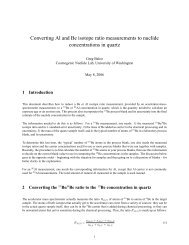Be exposure age calculator MATLAB function reference Version 2
Be exposure age calculator MATLAB function reference Version 2
Be exposure age calculator MATLAB function reference Version 2
You also want an ePaper? Increase the reach of your titles
YUMPU automatically turns print PDFs into web optimized ePapers that Google loves.
2.6 ET objective.m<br />
miss = ET_objective(E,cs,target,dFlag)<br />
This is the objective <strong>function</strong> used by get_al_be_erosion to solve for the erosion rate.<br />
The argument E is the erosion rate.<br />
The argument target is the measured number of atoms to which the predicted value will be compared (atoms · g −1 ).<br />
Thus, the value of E that yields miss = 0 solves the equation.<br />
The argument cs is a structure with the following fields:<br />
cs.tv Time vector (yr) 1xn double array<br />
cs.P sp t<br />
Surface production rate due to spallation at times corresponding<br />
1xn double array<br />
to those in cs.tv (atoms · g −1· yr −1 )<br />
cs.z mu Vector of depths. This is generally [0 1xm double array<br />
logspace(0,5.3,100)] plus half the sample thickness.<br />
That is, we linearize P (z) within the sample<br />
to get the thickness-aver<strong>age</strong>d value of P µ that is in<br />
cs.P_mu_z. (g · cm −2 )<br />
cs.P mu z<br />
Production rates due to muons at depths in cs.z mu. 1xm double array<br />
(atoms · g −1· yr −1 )<br />
cs.l Decay constant for nuclide of interest (yr −1 ) double<br />
cs.tsf Thickness scaling factor (nondimensional) double<br />
cs.L<br />
Effective attenuation length for spallogenic production<br />
(g · cm −2 )<br />
double<br />
The argument dflag is a string variable telling the <strong>function</strong> what to return. If dflag = ‘no,’ the output is just<br />
the objective <strong>function</strong> value, that is, the number of atoms difference between the measured value (target) and that<br />
predicted by the supplied erosion rate. If dflag = ‘yes,’ the output is a structure containing diagnostic information,<br />
as follows:<br />
miss.ver <strong>Version</strong> number of this <strong>function</strong> string<br />
miss.Nmu<br />
Nuclide concentration in sample attributable to production<br />
double<br />
by muons at the given erosion rate (atoms ·<br />
g −1 )<br />
miss.Nsp<br />
Nuclide concentration in sample attributable to production<br />
double<br />
by spallation at the given erosion rate (atoms ·<br />
g −1 )<br />
miss.expected Nsp,<br />
miss.PP, miss.A, miss.tsf<br />
Assorted diagnostics. Some are optional – generally<br />
depending on whether time-dependent or steady production<br />
is being used.<br />
various<br />
This <strong>function</strong> calculates the following:<br />
∫ ∞<br />
S thick P sp,0 (t)e (−ɛt/Λsp) e −λt dt +<br />
∫ ∞<br />
0<br />
0<br />
P µ (ɛt + δz/2)e −λt dt − N m (38)<br />
30



